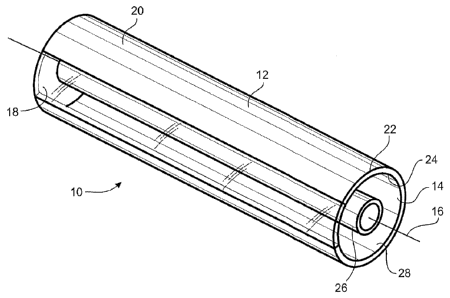Some of the information on this Web page has been provided by external sources. The Government of Canada is not responsible for the accuracy, reliability or currency of the information supplied by external sources. Users wishing to rely upon this information should consult directly with the source of the information. Content provided by external sources is not subject to official languages, privacy and accessibility requirements.
Any discrepancies in the text and image of the Claims and Abstract are due to differing posting times. Text of the Claims and Abstract are posted:
| (12) Patent: | (11) CA 2925706 |
|---|---|
| (54) English Title: | SOLAR ENERGY COLLECTOR AND SYSTEM FOR USING SAME |
| (54) French Title: | COLLECTEUR D'ENERGIE SOLAIRE ET SON SYSTEME D'UTILISATION |
| Status: | Granted |
| (51) International Patent Classification (IPC): |
|
|---|---|
| (72) Inventors : |
|
| (73) Owners : |
|
| (71) Applicants : |
|
| (74) Agent: | CASSAN MACLEAN IP AGENCY INC. |
| (74) Associate agent: | |
| (45) Issued: | 2017-05-16 |
| (86) PCT Filing Date: | 2014-05-20 |
| (87) Open to Public Inspection: | 2015-04-02 |
| Examination requested: | 2016-12-13 |
| Availability of licence: | N/A |
| (25) Language of filing: | English |
| Patent Cooperation Treaty (PCT): | Yes |
|---|---|
| (86) PCT Filing Number: | PCT/US2014/038685 |
| (87) International Publication Number: | WO2015/047456 |
| (85) National Entry: | 2016-03-29 |
| (30) Application Priority Data: | ||||||
|---|---|---|---|---|---|---|
|
A solar energy collector includes a first member having a cavity and a longitudinal axis. The first member has a longitudinal window forming a part thereof and a body forming another part thereof. The longitudinal window is made of a material adapted to be transparent to solar radiation. The body has an exterior absorptive surface and an interior reflective surface. A second member is located within the cavity of the first member and is generally parallel to longitudinal axis of the first member. The second member is adapted to carry an energy absorbing fluid. An insulative material fills the cavity between the first member and the second member. A solar energy collection system includes the form going solar energy collector and a solar energy transmitting device for directing solar energy through the window of the collector.
L'invention concerne un collecteur d'énergie solaire, qui comprend un premier élément ayant une cavité et un axe longitudinal. Le premier élément a une fenêtre longitudinale formant une partie de ce dernier et un corps formant une autre partie de ce dernier. La fenêtre longitudinale est faite d'un matériau conçu pour être transparent à un rayonnement solaire. Le corps comprend une surface absorbante extérieure et une surface réfléchissante intérieure. Un second élément est placé à l'intérieur de la cavité du premier élément et est sensiblement parallèle à l'axe longitudinal du premier élément. Le second élément est conçu pour transporter un fluide d'absorption d'énergie. Un matériau isolant remplit la cavité entre le premier élément et le second élément. Un système de collecte d'énergie solaire comprend le collecteur d'énergie solaire ci-dessus et un dispositif de transmission d'énergie solaire pour diriger l'énergie solaire à travers la fenêtre du collecteur.
Note: Claims are shown in the official language in which they were submitted.
Note: Descriptions are shown in the official language in which they were submitted.

For a clearer understanding of the status of the application/patent presented on this page, the site Disclaimer , as well as the definitions for Patent , Administrative Status , Maintenance Fee and Payment History should be consulted.
| Title | Date |
|---|---|
| Forecasted Issue Date | 2017-05-16 |
| (86) PCT Filing Date | 2014-05-20 |
| (87) PCT Publication Date | 2015-04-02 |
| (85) National Entry | 2016-03-29 |
| Examination Requested | 2016-12-13 |
| (45) Issued | 2017-05-16 |
There is no abandonment history.
Last Payment of $125.00 was received on 2024-04-22
Upcoming maintenance fee amounts
| Description | Date | Amount |
|---|---|---|
| Next Payment if standard fee | 2025-05-20 | $347.00 |
| Next Payment if small entity fee | 2025-05-20 | $125.00 |
Note : If the full payment has not been received on or before the date indicated, a further fee may be required which may be one of the following
Patent fees are adjusted on the 1st of January every year. The amounts above are the current amounts if received by December 31 of the current year.
Please refer to the CIPO
Patent Fees
web page to see all current fee amounts.
| Fee Type | Anniversary Year | Due Date | Amount Paid | Paid Date |
|---|---|---|---|---|
| Application Fee | $200.00 | 2016-03-29 | ||
| Maintenance Fee - Application - New Act | 2 | 2016-05-20 | $50.00 | 2016-03-29 |
| Request for Examination | $400.00 | 2016-12-13 | ||
| Final Fee | $150.00 | 2017-04-04 | ||
| Maintenance Fee - Patent - New Act | 3 | 2017-05-23 | $50.00 | 2017-05-18 |
| Maintenance Fee - Patent - New Act | 4 | 2018-05-22 | $50.00 | 2018-05-16 |
| Maintenance Fee - Patent - New Act | 5 | 2019-05-21 | $100.00 | 2019-05-15 |
| Maintenance Fee - Patent - New Act | 6 | 2020-05-20 | $100.00 | 2020-05-11 |
| Maintenance Fee - Patent - New Act | 7 | 2021-05-20 | $100.00 | 2021-04-08 |
| Maintenance Fee - Patent - New Act | 8 | 2022-05-20 | $100.00 | 2022-05-09 |
| Maintenance Fee - Patent - New Act | 9 | 2023-05-23 | $100.00 | 2023-04-19 |
| Maintenance Fee - Patent - New Act | 10 | 2024-05-21 | $125.00 | 2024-04-22 |
Note: Records showing the ownership history in alphabetical order.
| Current Owners on Record |
|---|
| IM, DO SUN |
| Past Owners on Record |
|---|
| None |